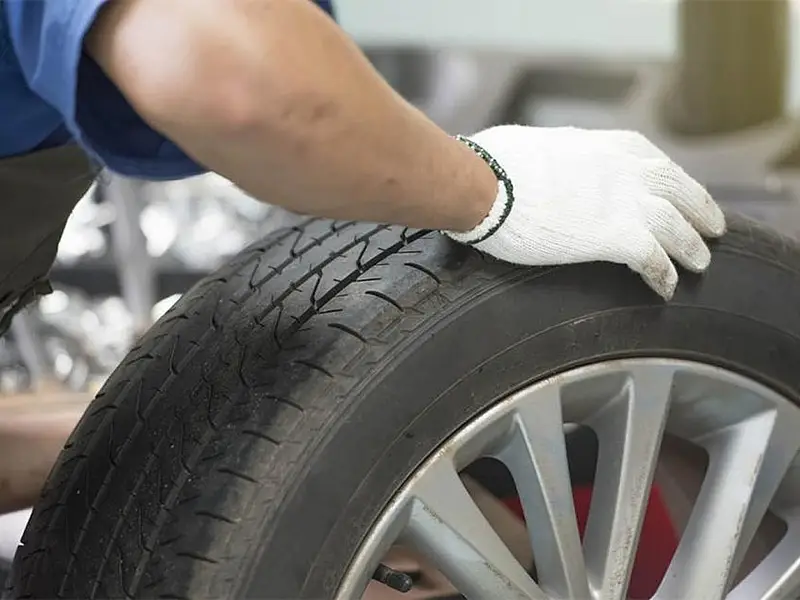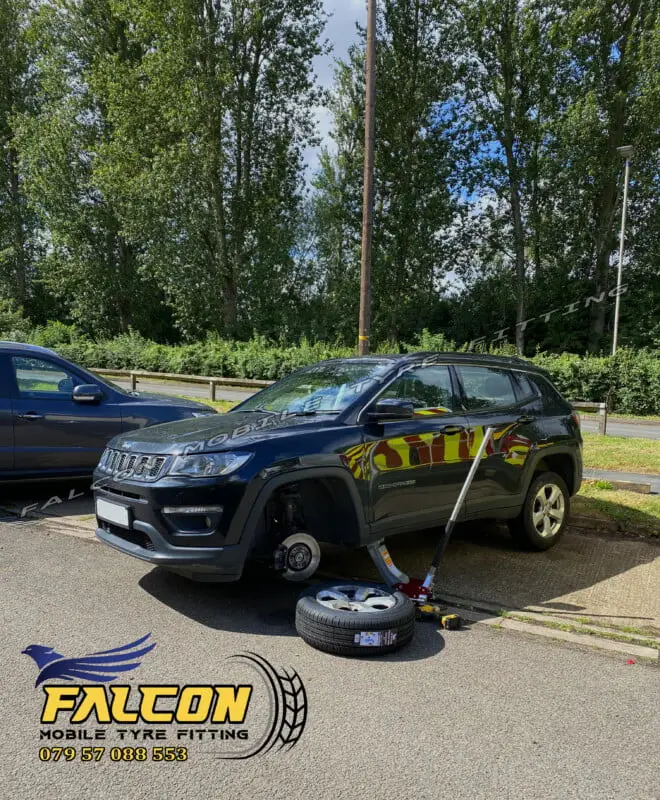Is it snowing outside? Or are the temperatures so hot that it’s hard to breathe? So, you keep asking yourself: When should you change your tyres? Well, tyres play a crucial role in vehicle safety, as well as its performance and efficiency. They are basically your main contact between your car and the road. This means that their condition directly impacts grip, handling, and braking when driving. Obviously, one of the most common reasons for tyre replacement is the change in weather conditions. Fitting the appropriate tyres for the season is essential for optimal performance and road safety. So, why, and when should you change your tyres? And what are the different types of tyres available to you? Read below to find out!
When should you change your tyres | Why it is important to change tyres as the seasons change
As temperatures move up and down, changing throughout the year, so do road conditions. The wrong set of tyres can lead to significantly reduced traction, increased braking distance, and a higher risk of accidents. Summer, winter, and all-season tyres each have their own characteristics for different conditions, making it imperative to switch them accordingly. Summer tyres, for example, provide optimal grip and stability on hot, dry roads, whereas winter tyres are better designed to handle snowy, icy, and extremely cold conditions.
All-season tyres, on the other hand, offer a balanced solution for moderate climates but may not perform as well as dedicated seasonal tyres in extreme conditions. Not changing your tyres at the appropriate time can lead to severe consequences, like hydroplaning on wet roads, loss of control on icy surfaces, and decreased fuel efficiency because of the increased resistance. That is why, when you understand the impact of seasonal changes on road safety, you can take proactive measures to ensure yor car’s tyres are always suited to the weather conditions.
Types of Tyres and Their Uses | When should you change your tyres
- Winter Tyres
Winter tyres are designed specifically for use in extreme cold, snowy, and icy conditions. They are made of a softer type of rubber that remains flexible even in temperatures below 7°C, ensuring better grip and traction. The deeper grooves provide much better control on snow-covered roads, which in turn always prevents slippage and reduces braking distances. Unlike all-season or summer tyres, winter tyres have specially designed tread patterns that help remove snow and slush more effectively, reducing the risk of hydroplaning. Additionally, they have an increased number of sipes which increases the traction on ice, making winter driving safer and more manageable. So, when should you change your tyres to winter tyres? Once the temperature drops consistently below 7°C.
- Mud & Snow (M+S) Tyres
You will see that mud and snow tyres are very often mistaken for winter tyres, but they are designed for milder winter conditions. They have deeper tread patterns than summer tyres, providing enhanced grip on wet and lightly snow-covered roads. However, they lack the flexibility and advanced traction of dedicated winter tyres, making them unsuitable for extremely icy conditions. These tyres are ideal for regions that experience occasional snowfall but do not face prolonged icy conditions. While they offer better grip than summer tyres, they do not provide the same level of control and stability as winter tyres, making them a less optimal choice for harsh winters.
- All-Season Tyres
All-season tyres are a hybrid solution for those who do not wish to change tyres twice a year. They offer moderate performance in both summer and winter conditions but do not excel in either one or the other. Although they are very convenient, they are not the best choice for extreme weather conditions, because their performance is a compromise between summer and winter tyres. The rubber used in all-season tyres is designed to provide a balance of durability and flexibility, but it does not remain as soft as winter tyres in extreme cold, nor does it provide the optimal grip of summer tyres in high temperatures. This makes them suitable for regions with moderate climates but much less effective in areas with severe winter weather.
- Summer Tyres
Summer tyres are optimized for warm weather driving. They have a harder rubber compound that provides great traction on dry and wet roads in temperatures above 7°C. These tyres are not suitable for cold conditions, as the rubber hardens, reducing grip and increasing braking distance. Summer tyres also have tread patterns that try to maximize surface contact with the road, improving stability and fuel efficiency. However, in cold temperatures or snowy conditions, their effectiveness drops significantly, which leads to an increased risk of skidding or longer stopping distances.

When should you change your tyres ?
As you also read form the description above, changing tyres according to the season is very important to maintaining safety and efficiency. Here are the key factors you should consider when making the decision to change your car tyres according to the weather:
- Temperature Drops Below 7°C When temperatures start falling below 7°C, summer tyres lose their flexibility and become less effective. This is perfect time to switch to winter tyres, which are designed to maintain grip and stability in colder conditions. The specialized rubber compounds used in winter tyres ensure optimal performance even in freezing temperatures.
- Snow and Ice on the Roads If you frequently drive in areas with heavy snowfall or icy roads, winter tyres are a must. They provide much better traction and handling in extreme conditions, significantly reducing the risk of skidding. Additionally, they reduce braking distances, which allows the driver to have better control over the vehicle in dangerous conditions.
- Spring and Warmer Weather Once winter ends and temperatures rise above 7°C consistently, it’s the best time to switch back to summer tyres. Driving on winter tyres in warm conditions accelerates their wear and reduces fuel efficiency. Summer tyres perform optimally in warm weather and provide better stability and braking performance.
When should you change your tyres | Other Signs That Indicate Tyre Replacement
But of course, when deciding when should you change your tyres, you should know that weather changes are not the only reason for replacement. Other indicators include:
- Tread Depth The legal tread depth for tyres is a minimum of 1.6mm. However, experts recommend changing tyres once the tread depth reaches 3mm for safety reasons. A quick way to check tread depth is by inserting a coin into the grooves; if the tread does not cover a portion of the coin, it’s time for new tyres. Shallow treads significantly reduce traction on wet surfaces, increasing the likelihood of aquaplaning.
- Age of the Tyres Tyres should be replaced every 5 to 6 years, regardless of their condition. After ten years, tyres must be replaced immediately, as rubber degrades over time, leading to a loss of grip. And, consistent exposure to heat, sunlight, and environmental conditions accelerates this deterioration.
- Bulges and Cracks If you notice bulging, cracks, or cuts in your tyres, it’s a sign of structural weakness. Such tyres are more prone to blowouts, which can be dangerous at high speeds. These defects are usually created from manufacturing flaws, rough road conditions, or prolonged exposure to extreme temperatures.
- Excessive Vibrations If you experience unusual vibrations while driving, it may indicate tyre imbalance or internal damage. If vibrations continue even after alignment and balancing, tyre replacement is recommended. Uneven wear patterns can cause discomfort and affect vehicle handling.
The Role of Proper Tyre Pressure | When should you change your tyres
Maintaining correct tyre pressure is important for longevity of your tyres, but also for fuel efficiency and road safety. Under-inflated tyres increase rolling resistance, while over-inflated tyres reduce grip and cause uneven tread wear. You should be regularly checking tyre pressure, at least once a month and before long journeys, in order to prevent premature tyre wear and ensures optimal performance. Proper inflation also improves braking efficiency and extends tyre lifespan.
Falcon Mobile Tyres Fitting – The Most Reliable Tyre Service in Southeast London & Kent
For residents of Southeast London and Kent, Falcon Mobile Tyres Fitting offers a great mobile tyre fitting service, bringing convenience directly to your doorstep. Whether you need a tyre replacement, puncture repair, or seasonal tyre change, Falcon provides expert solutions without the hassle of visiting a garage. Our skilled technicians are equipped with the latest tools to cater to all vehicle types, ensuring a seamless and efficient experience. Prioritizing safety and convenience, Falcon Mobile Tyres Fitting is the go-to choice for professional tyre care. Schedule your needed service easily today, by clicking here!
Your tyres are a critical component of your vehicle, and changing them according to the season and their condition is vital for road safety. Understanding the differences between summer, winter, and all-season tyres ensures you make the right choice based on your driving habits and local weather conditions. Regular maintenance, including checking tread depth, tyre pressure, and general wear, can extend the life of your tyres and improve your overall driving experience.
For hassle-free and professional tyre replacement in Southeast London and Kent, trust Falcon Mobile Tyres Fitting to keep you safe on the road.



